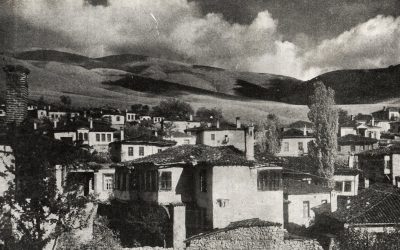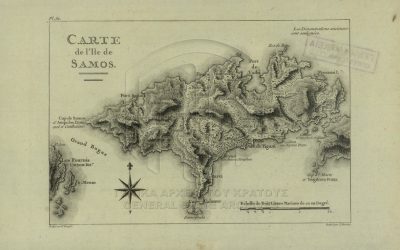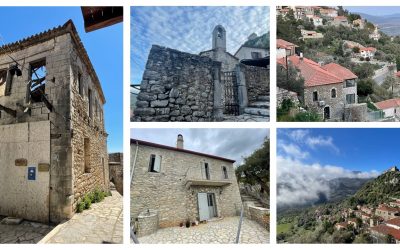In part one of “Milestones in Greek Electoral History” we talked about the most important electoral battles in 19th- and early 20th-century Greece. Leaving back the “long 19th century” and the outbreak of the First World War together with its consequences, the political and electoral landscape in Greece changed radically, as it was marked by the big national and global developments of the 20th century. In this article we will focus on milestones in Greek electoral history from the end of the Second World War until 1981.
The fateful elections of 1946: Prelude to the Greek Civil War
The elections of 1946 were held in the context of the post-Second World War period, following the German invasion, occupation, and the country’s liberation in 1944.[1] It was a period of intense social upheaval, political polarization, and foreign interventions. The exuberance of the liberation could not prevent the division between the forces of the main movement of the Greek Resistance, known as EAM (National Liberation Front), and the British and Greek governmental forces. The collision took the form of an armed conflict, known as the “December Events,” which occurred between December 1944 and January 1945 in Athens and was temporarily terminated by the “Treaty of Varkiza” in February 1945.[2]
In the beginning of 1946, the appointed government of politician Themistoklis Sofoulis, announced national elections on March 31st of the same year, under the instructions of the British army.[3] However, the EAM, represented by the Greek Communist Party, asked for a two-month postponement and reassurances regarding the validity of the elections, wheeling out the persecutions and violence that broke out against their members, following the “Treaty of Varkiza” and the disarmament of their armed groups.[4] Their demand was overruled, and as a result, the Communist Party decided to abstain from the elections.[5]
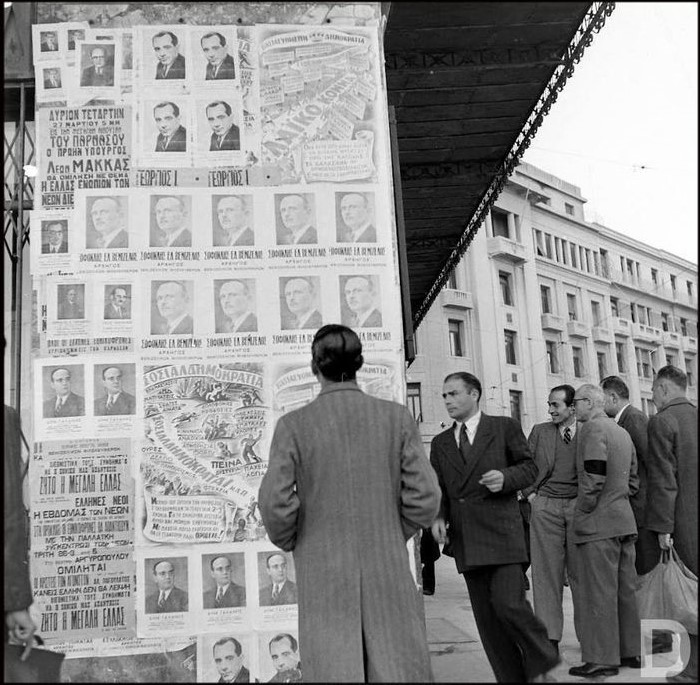
In this way, with the Left abstaining and the centrist political parties being diluted and in disorder, the right-wing parties grouped together in an electoral alliance called “Inomeni Parataxis Ethnikophronon”.[6] The alliance emerged as the winning party, with a 55,12 % share of the votes, securing 206 seats in the new 345-seat parliament.[7] The largest component of the alliance was the royalist “Laikon Komma”, which secured 156 out of the coalition’s total parliamentary seats.[8] The two centrist political parties, “Ethniki Politiki Enosis” and the “Liberal Party” of Themistoklis Sofoulis, together reached the percentage of 34,67 % of the votes, securing 116 seats in the parliament.[9] Following the elections, which were held under the proportional representation electoral system, a short-lived coalition government was created.[10] Finally, in April 1946, politician Konstantinos Tsaldaris formed a government with representatives mainly from Laikon Komma.[11]
As for the abstention of the Left from the elections, the opinions have differed over time, as the number of the eligible voters was never announced.[12] On the one hand, the Greek Communist Party has talked about a 50% abstention rate.[13] On the other, the 1946 “Allied Mission to Observe the Greek Elections (AMFOGE),” whose teams visited the Greek polling stations, estimated that 9,3% of the registered voters, or some 15% of those who had actually participated, had abstained from the elections for political reasons.[14] Still, it has been suggested that such estimates were likely based on speculation, and recent historical studies have estimated an abstention rate of 20-25%.[15] In any case, the elections of 1946 proved to be one of the milestones in Greek Electoral history, as the abstention triggered the escalation of the armed conflict and the beginning of the Greek Civil War (1946-1947). The three-year civil conflict had devastating consequences for the country, laying the foundations for a prolonged period of sociopolitical divisions, and leaving a lasting impact on Greece’s collective memory.
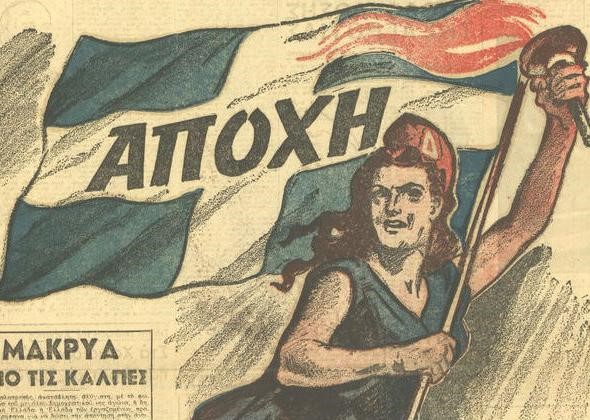
The elections of 1958: A plot twist in the post-war normality
In the beginning of March 1958, Konstantinos Karamanlis, the president of the political party that was in power since 1952, asked for the dissolution of the Parliament and announced national elections on May 11.[16] He aimed to consolidate his position as the leader of his party “Eniaia Rizospastiki Enosis” (ERE) and stabilize the political crisis that had recently occurred, after the resignation of two ministers and thirteen representatives of ERE.[17] Specifically, ERE and the Liberal Party of Georgios Papandreou, had agreed to the establishment of a new electoral system with bonus, according to which, the two parties with the most votes would be subsidized with additional parliamentary seats, against the other elected parties.[18] The final goal, was to weaken EDA (United Democratic Left), the biggest legitimate left-wing party, which was expected to be the third one in the race[19] The new electoral law had caused reactions not only from the opposition parties, but also from ERE, resulting in the political deadlock of 1958.[20]
However, the elections had an unprecedented outcome. Apart from ERE, which was the unquestionable winner with 41,16% of the voters and 171 seats in the Parliament, EDA emerged as the major opposition party for the first time in Greek electoral history.[21] It reached the percentage of 24,42% (securing the biggest number of parliamentary seats in its own history, thanks to the new electoral system), under the leadership of Ioannis Pasalidis.[22] On the contrary, the Liberal Party, under the coalition of Georgios Papandreou and Sofoklis Venizelos, was defeated, receiving a percentage of 20,76% and securing 36 seats.[23] The formerly dominant “Laikon Komma”, received only 2,94% in what proved to be its last electoral race.[24]
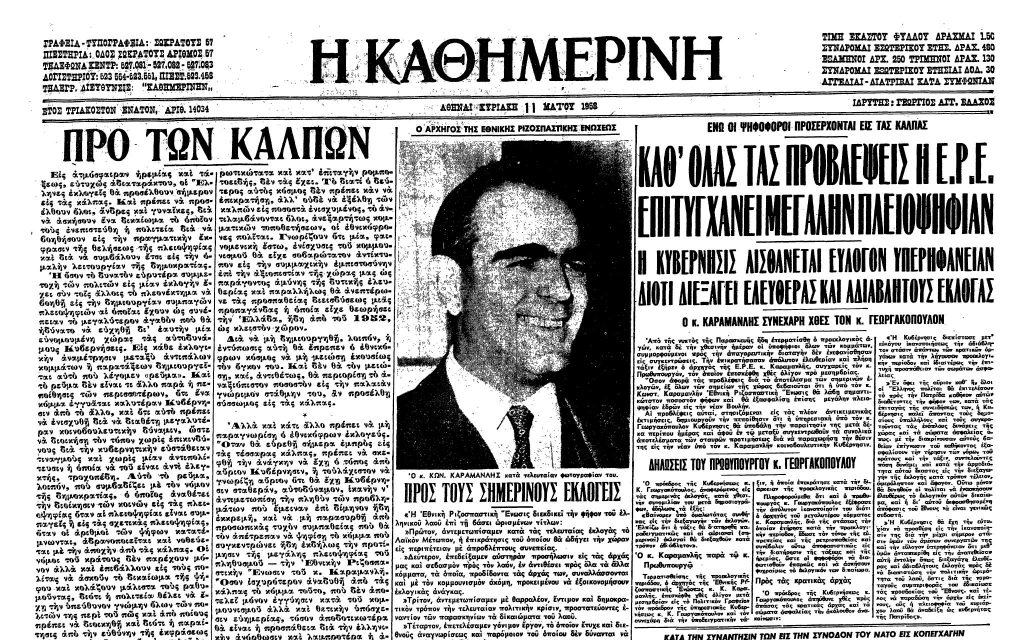
Therefore, the elections of 1958 constituted one of the milestones in Greek Electoral history, as the “normality,” which had been formed in the Greek political landscape after the Greek Civil War, was ruptured almost a decade later with EDA’s surprising success.[25] In addition, it seems that the 1958 elections marked the end of a previous political era, with the shattering of the old political formations and correlations. The turbulent decade of the 1960s would soon arrive, bringing profound political developments and a dark seven-year period of dictatorship in Greece.
The elections of 1974: Transition to Democracy
The elections of 1974 were the first free national elections in Greece after the end of the Colonels’ regime (1967-1974).[26] After the fall of the Junta, in July 1974, a national unity government was established. In the pre-election period, new political parties and correlations were formed, which would forge the Greek political history as we know it today.[27]
Konstantinos Karamanlis returned to Greece and as a leading figure in the democratic transition founded a new political party, called “New Democracy”.[28] In September 1974, Andreas Papandreou withdrew from the pro-Junta party of his father Georgios Papandreou called “Enosi Kentrou”, and founded the “Panhellenic Socialist Movement” known mostly as PASOK.[29] Lastly, the Greek Communist Party became legal again, after almost three decades in illegitimacy (a consequence of the Greek Civil War).[30] In fact, being divided in two Communist parties, Internal and External, since 1968, both of them formed an alliance with EDA, called “United Left”.[31] The External Communist Party participated in the electoral race under the leadership of Charilaos Florakis, an erstwhile political prisoner.[32]
In anticipation of the elections of November 1974, the transition to democracy was realized and sustained. The temporary unity government of Karamanlis embraced figures from the social-democratic front with anti-dictatorial activity, in order to emphasize the change from the old regime.[33] Some leading members of the dictatorial regime were symbolically arrested, and a referendum for changing the governmental system was announced.[34] The process of democratization proved to be rapid (hence it was characterized as “velvet”), also due to the events of the Turkish invasion in Cyprus, in which the Colonels’ Regime had played a crucial role.[35] Thus, the dilemma of a “long” or “slow” transitional period was no longer relevant.[36]

In the electoral race that took place on November 17, 1974, “New Democracy” led by Konstantinos Karamanlis was the winning party, receiving an impressive percentage of over 54%.[37] His appeal reached not only the traditional electoral base, but also a part of the communist left, seeking political stability and a conclusive restoration of democracy.[38] The popular phrase “Karamanlis or tanks” is indicative of the general atmosphere. Next, the opposition parties “Enosi Kentrou”, “PASOK” and the United left received percentages of 20, 13,5 and 9,5% respectively.[39]
The message of the elections of November 1974 was validated by the result of the referendum, which took place soon afterwards. The majority of the Greek people (70%) voted against the reinstatement of the monarchy and in favor of a Democratic Republic.[40] Undoubtedly, the electoral chapter of 1974 can be seen as one of the biggest milestones in Greek electoral history, signifying the transition to democracy and setting the stage for the contemporary political landscape in Greece. With the interim election race of 1977, in which the Greek electorate was likely on hold, the democratization would be solidified a few years later.[41] The elections of 1981 would be regarded as a breakthrough, as the rise of the social-democratic PASOK would mark the social and political change: the termination of the sociopolitical discriminations between the winners and the defeated of the Greek Civil War (the right-left dipole) with the recognition of the Greek Resistance.[42] With PASOK’s rise, a two-party system was introduced and would last until the Greek financial crisis starting in 2009.
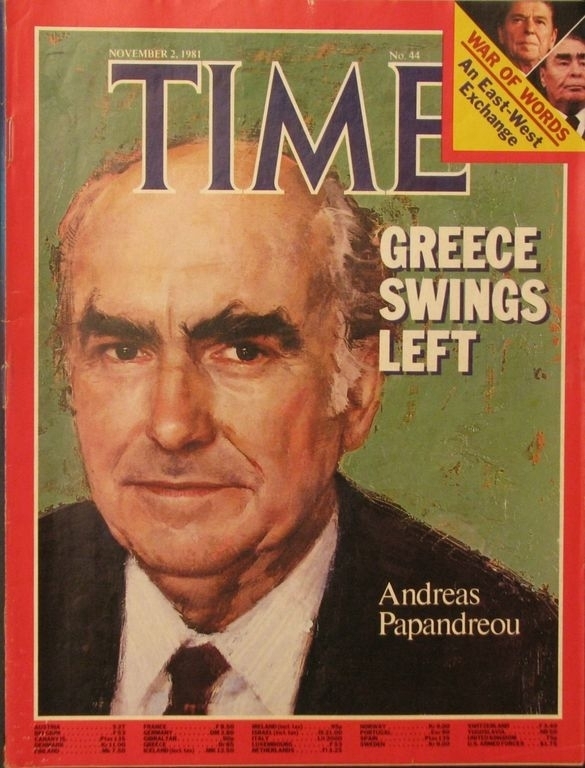
About the Author
Maro Rempoutsika studied history at the University of Athens and the University of Groningen. She works as a research assistant at Greek Ancestry.
[1] San simera.gr, Accessed June 21, 2023
[2] Also known as “Dekemvriana” or the “Battle of Athens”.
The Treaty of Varkiza was signed on February 12, 1945 by the then government of Nikolaos Plastiras and representatives of the National Liberation Front (EAM) following the December Events, according to which the EAM Forces were obliged to evacuate Attica and Thessaloniki, in the context of a ceasefire from both sides.
[3] San simera.gr
[4] San simera.gr
[5] San simera.gr
[6] Richard Clogg, Parties and Elections in Greece: The Search for Legitimacy (Duke University Press, February 1988), 17-22
[7] Clogg, Parties and Elections, 17-22
[8] Clogg, Parties and Elections, 17-22
[9] Clogg, Parties and Elections, 17-22
[10] Clogg, Parties and Elections, 17-22
[11] Clogg, Parties and Elections, 17-22
[12] San simera.gr
[13] San simera.gr
[14] Clogg, Parties and Elections, 17-22
[15] San simera.gr,
Clogg, Parties and Elections, 17-22
[16] “Ellinikes Vouleutikes Ekloges 1958”, Wikipedia, Accessed June 21, 2023, https://el.wikipedia.org/wiki/%CE%95%CE%BB%CE%BB%CE%B7%CE%BD%CE%B9%CE%BA%CE%AD%CF%82_%CE%B2%CE%BF%CF%85%CE%BB%CE%B5%CF%85%CF%84%CE%B9%CE%BA%CE%AD%CF%82_%CE%B5%CE%BA%CE%BB%CE%BF%CE%B3%CE%AD%CF%82_1958
“San simera: 11 Maiou 1958”, Kathimerini.gr, Accessed June 21, 2023
[17] Kathimerini.gr, “San simera”
[18] “Oi Ekloges tou 1958”, Kathimerini.gr, Accessed June 21, 2023
[19] Wikipedia, “Ekloges 1958”
[20] Kathimerini.gr, “Oi Ekloges 1958”
[21] Kathimerini.gr, “San simera”
Wikipedia, “Ekloges 1958”
[22] Kathimerini.gr, “San simera”
Wikipedia, “Ekloges 1958”
[23] Kathimerini.gr, “Oi Ekloges 1958”
[24] Kathimerini.gr, “Oi Ekloges 1958”
[25] Kathimerini.gr, “San simera”
[26]Ioannidis.P., Tsaousakis.I, Nikolakopoulos,I.,“Ekloges 1974”, 2023, in Oi Eklogikes Anametriseis 1974-2019, Produced by NEWS24/7, Podcast, mp3,
[27] Ioannidis, “Ekloges 1974”
[28] Ioannidis, “Ekloges 1974”
[29] Ioannidis, “Ekloges 1974”
[30] Ioannidis, “Ekloges 1974”
[31] Ioannidis, “Ekloges 1974”
[32] Ioannidis, “Ekloges 1974”
[33] Ioannidis, “Ekloges 1974”
[34] Ioannidis, “Ekloges 1974”
[35] Ioannidis, “Ekloges 1974”
[36] Ioannidis, “Ekloges 1974”
[37] Ioannidis, “Ekloges 1974”
[38] Ioannidis, “Ekloges 1974”
[39] Ioannidis, “Ekloges 1974”
[40] Ioannidis, “Ekloges 1974”
[41] Ioannidis.P., Tsaousakis.I, Koustenis.I.,“Ekloges 1981”, 2023, in Oi Eklogikes Anametriseis 1974-2019, Produced by NEWS24/7, Podcast, mp3,
[42] Ioannidis., “Ekloges 1981”

